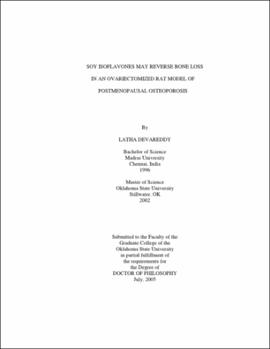| dc.contributor.advisor | Arjmandi, Bahram H. | |
| dc.contributor.author | Devareddy, Latha | |
| dc.date.accessioned | 2013-11-26T08:26:18Z | |
| dc.date.available | 2013-11-26T08:26:18Z | |
| dc.date.issued | 2005-07 | |
| dc.identifier.uri | https://hdl.handle.net/11244/6857 | |
| dc.description.abstract | Scope and Method of Study: Soy protein is reported to prevent bone loss in both women and rat models of osteoporosis. However, the role of soy isoflavones on the trabecular microarchitectural properties needs to be explored. In the present study, we examined whether soy protein with graded doses of isoflavones reverses loss of bone mineral density (BMD), bone mineral content (BMC), and trabecular microstructure in an ovariectomized (Ovx) osteopenic rat model. Seventy-eight 9-m old female Sprague-Dawley rats were either sham-operated (Sham; 1 group) or Ovx (5 groups) and fed a semi-purified casein-based diet. After 90 days the occurrence of bone loss was confirmed using dual energy x-ray absorptiometry. Thereafter, rats were assigned to the following treatments: Sham, Ovx (control), Ovx+17B-estradiol (E2; 10 Mg/kg body wt. twice per wk), Ovx + soy protein depleted of isoflavones (Soy-; 0.06 mg isoflavones/g protein), Ovx + soy protein with normal isoflavone content (Soy; 3.55 mg isoflavones/g protein), and Ovx + soy protein enriched isoflavones (Soy+; 7.10 mg isoflavones/g protein). | |
| dc.description.abstract | Findings and Conclusions: After 125 days of treatment, rats were euthanized and tissues were collected for the assessment of BMD and BMC, and tibial and 4th lumbar trabecular micro-architectural properties via x-ray microcomputed tomography. Soy significantly increased tibial BMC and BMD by 10 % and 4.5% in comparison with Ovx control, whereas the effects of Soy-, Soy+ and E2 were less pronounced. All of the soy-based diets, irrespective of their isoflavone content, had a modest effect on the lumbar BMD. However, only the Soy+ diet positively affected the tibial architectural properties including trabecular thickness, separation, and number. None of the treatments had any effect on trabecular microarchitectural properties of the fourth lumbar vertebra. In summary, our findings suggest that isoflavones may exert a biphasic effect on tibial BMD, and higher doses of isoflavones may be required to reverse the loss of tibial microstructural properties. | |
| dc.format | application/pdf | |
| dc.language | en_US | |
| dc.rights | Copyright is held by the author who has granted the Oklahoma State University Library the non-exclusive right to share this material in its institutional repository. Contact Digital Library Services at lib-dls@okstate.edu or 405-744-9161 for the permission policy on the use, reproduction or distribution of this material. | |
| dc.title | Soy isoflavones may reverse bone loss in an ovariectomized rat model of postmenopausal osteoporosis | |
| dc.contributor.committeeMember | Smith, Brenda J. | |
| dc.contributor.committeeMember | Lucas, Edralin A. | |
| dc.contributor.committeeMember | Pope, Carey N. | |
| osu.filename | Devareddy_okstate_0664D_1479.pdf | |
| osu.accesstype | Open Access | |
| dc.type.genre | Dissertation | |
| dc.type.material | Text | |
| thesis.degree.discipline | Human Environmental Sciences | |
| thesis.degree.grantor | Oklahoma State University | |
